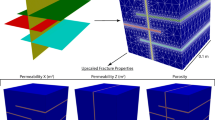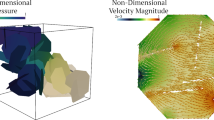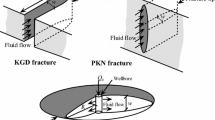Abstract
We present a new, fully dynamic pore-network modeling platform that is employed to conduct a systematic pore-scale study of capillary trapping under various two-phase flow conditions in a rough-walled fracture. The model rigorously solves for the fluid pressure fields, incorporates detailed descriptions of pore-scale fluid interface dynamics, and explicitly accounts for flow through wetting layers. This modeling platform further benefits from heavy parallelization and advanced domain decomposition techniques to achieve computational efficiency. We first build an equivalent pore network of a rough-walled Berea sandstone fracture using its high-resolution x-ray images. Next, to validate the dynamic model, primary drainage and imbibition simulations are conducted with fluid properties and boundary conditions matching their experimental counterparts. We show that the predicted two-phase fluid occupancy maps for both displacement processes agree well with those observed experimentally using x-ray computed tomography. Afterward, a comprehensive simulation study of flow patterns and capillary trapping during imbibition is performed under varying flow conditions, fluid properties, and initial saturations. The generated results provide significantly improved insights into the effects of wettability, gravity and viscous forces, and initial non-wetting (NW) phase saturation on the morphology and size distribution of the trapped NW phase clusters and the final residual NW phase saturation. By revealing the interplay among the capillary, buoyancy, and viscous forces, our results create a guideline on how the removal of NW phase from fractured media can be influenced by adjusting the operational settings. These findings have broad implications for predictions of capillary trapping behavior in fractured media.

























Similar content being viewed by others
Code Availability
Custom code.
References
Aissaoui, A.: Etude théorique et expérimentale de l’hystérésis des pressions capillaires et des perméabilités relatives en vue du stockage souterrain de gaz. Ecole des Mines de Paris, Paris (1983)
Al Mansoori, S., Iglauer, S., Pentland, C.H., Bijeljic, B., Blunt, M.J.: Measurements of non-wetting phase trapping applied to carbon dioxide storage. Energy Proc. 1(1), 3173–3180 (2009)
Arshadi, M., Khishvand, M., Aghaei, A., Piri, M., Al-Muntasheri, G.: Pore-scale experimental investigation of two-phase flow through fractured porous media. Water Resour. Res. 54(5), 3602–3631 (2018)
Balay, S., Abhyankar, S., Adams, M.F., Brown, J., Brune, P., Buschelman, K., Dalcin, L., Dener, A., Eijkhout, V., Gropp, W.D., Karpeyev, D., Kaushik, D., Knepley, M.G., May, D.A., McInnes, L.C., Mills, R.T., Munson, T., Rupp, K., Sanan, P., Smith, B.F., Zampini, S., Zhang, H., Zhang, H.: PETSc users manual. Technical Report ANL-95/11 - Revision 3.11, Argonne National Laboratory, (2019). http://www.mcs.anl.gov/petsc
Berre, I., Doster, F., Keilegavlen, E.: Flow in fractured porous media: A review of conceptual models and discretization approaches. Transp. Porous Media 130(1), 215–236 (2019)
Blunt, M., Fayers, F.J., Orr, F.M., Jr.: Carbon dioxide in enhanced oil recovery. Energy Conv. Manag. 34(9–11), 1197–1204 (1993)
Bogdanov, I.I., Mourzenko, V.V., Thovert, J.F., Adler, P.M.: Effective permeability of fractured porous media in steady state flow. Water Resour. Res. 39(1), 1023 (2003)
Bryant, S., Blunt, M.: Prediction of relative permeability in simple porous media. Phys. Rev. A 46(4), 2004 (1992)
Chatzis, I., Morrow, N.R.: Correlation of capillary number relationships for sandstone. Soc. Pet. Eng. J. 24(05), 555–562 (1984)
Chen, Y.F., Fang, S., Wu, D.S., Hu, R.: Visualizing and quantifying the crossover from capillary fingering to viscous fingering in a rough fracture. Water Resour. Res. 53(9), 7756–7772 (2017)
Chen, Y.F., Guo, N., Wu, D.S., Hu, R.: Numerical investigation on immiscible displacement in 3D rough fracture: Comparison with experiments and the role of viscous and capillary forces. Adv. Water Resour. 118, 39–48 (2018)
Ekechukwu, G.K., Khishvand, M., Kuang, W., Piri, M., Masalmeh, S.: The effect of wettability on waterflood oil recovery in carbonate rock samples: A systematic multi-scale experimental investigation, Transp. Porous Media (in press) (2020)
Ferer, M., Crandall, D., Ahmadi, G., Smith, D.H.: Two-phase flow in a rough fracture: experiment and modeling. Phys. Rev. E 84(1), 016316 (2011)
Fourar, M., Bories, S., Lenormand, R., Persoff, P.: Two-phase flow in smooth and rough fractures: Measurement and correlation by porous-medium and pipe flow models. Water Resour. Res. 29(11), 3699–3708 (1993)
Gilman, J.R., Kazemi, H.: Improvements in simulation of naturally fractured reservoirs. SPE Journal 23(04), 695–707 (1983)
Glass, R.J., Nicholl, M.J., Yarrington, L.: A modified invasion percolation model for low-capillary number immiscible displacements in horizontal rough-walled fractures: Influence of local in-plane curvature. Water Resour. Res. 34(12), 3215–3234 (1998)
Golparvar, A., Zhou, Y., Wu, K., Ma, J., Yu, Z.: A comprehensive review of pore scale modeling methodologies for multiphase flow in porous media. Adv. Geo-Energy Res. 2(4), 418–440 (2018)
Gong, Y., Piri, M.: Pore-to-core upscaling of solute transport under steady-state two-phase flow conditions using dynamic pore network modeling approach. Transp. Porous Media 135(1), 181–218 (2020)
Holmgren, C., Morse, R.: Effect of free gas saturation on oil recovery by water flooding. J. Pet. Technol. 3(05), 135–140 (1951)
Hu, R., Zhou, C.X., Wu, D.S., Yang, Z., Chen, Y.F.: Roughness control on multiphase flow in rock fractures. Geophys. Res. Lett. 46(21), 12002-12011 (2019)
Hughes, R.G., Blunt, M.J.: Network modeling of multiphase flow in fractures. Adv. Water Resour. 24(3–4), 409–421 (2001)
Huo, D., Benson, S.M.: Experimental investigation of stress-dependency of relative permeability in rock fractures. Transp. Porous Media 113(3), 567–590 (2016)
Iglauer, S., Wülling, W., Pentland, C.H., Al-Mansoori, S.K., Blunt, M.J.: Capillary-trapping capacity of sandstones and sandpacks. SPE J. 16(04), 778–783 (2011)
Jerauld, G.: General three-phase relative permeability model for prudhoe bay. SPE Reserv. Eng. 12(04), 255–263 (1997)
Joekar-Niasar, V., Hassanizadeh, S.M.: Effect of fluids properties on non-equilibrium capillarity effects: Dynamic pore-network modeling. Int. J. Multiphase Flow 37(2), 198–214 (2011)
Joekar-Niasar, V., Hassanizadeh, S.M., Dahle, H.: Non-equilibrium effects in capillarity and interfacial area in two-phase flow: dynamic pore-network modelling. J. Fluid Mech. 655, 38 (2010)
Juanes, R., MacMinn, C.W., Szulczewski, M.L.: The footprint of the CO2 plume during carbon dioxide storage in saline aquifers: storage efficiency for capillary trapping at the basin scale. Transp. Porous Media 82(1), 19–30 (2010)
Karpyn, Z., Grader, A., Halleck, P.: Visualization of fluid occupancy in a rough fracture using micro-tomography. J. Colloid Interface Sci. 307(1), 181–187 (2007)
Karpyn, Z.T., Piri, M.: Prediction of fluid occupancy in fractures using network modeling and x-ray microtomography. I: Data conditioning and model description. Phys. Rev. E 76(1), 016315 (2007)
Karypis, G., Kumar, V.: A fast and high quality multilevel scheme for partitioning irregular graphs. SIAM J. Sci. Comput. 20(1), 359–392 (1998). https://doi.org/10.1137/S1064827595287997
Khishvand, M., Akbarabadi, M., Piri, M.: Micro-scale experimental investigation of the effect of flow rate on trapping in sandstone and carbonate rock samples. Adv. Water Resour. 94, 379–399 (2016)
Khosravian, H., Joekar-Niasar, V., Shokri, N.: Effects of flow history on oil entrapment in porous media: An experimental study. AIChE J. 61(4), 1385–1390 (2015)
Kleppe, J., Delaplace, P., Lenormand, R., Hamon, G., Chaput, E.: Representation of capillary pressure hysteresis in reservoir simulation. In: SPE Annual Technical Conference and Exhibition, Society of Petroleum Engineers (1997)
Kong, B., Chen, S.: Numerical simulation of fluid flow and sensitivity analysis in rough-wall fractures. J. Pet. Sci. Eng. 168, 546–561 (2018)
Krevor, S., Blunt, M.J., Benson, S.M., Pentland, C.H., Reynolds, C., Al-Menhali, A., Niu, B.: Capillary trapping for geologic carbon dioxide storage-from pore scale physics to field scale implications. Int. J. Greenhouse Gas Control 40, 221–237 (2015)
Kumar, A., Noh, M.H., Ozah, R.C., Pope, G.A., Bryant, S.L., Sepehrnoori, K., Lake, L.W.: Reservoir simulation of CO2 storage in aquifers. SPE J. 10(03), 336–348 (2005)
Land, C.S.: Calculation of imbibition relative permeability for two-and three-phase flow from rock properties. Soc. Pet. Eng. J. 8(02), 149–156 (1968)
Lemonnier, P., Bourbiaux, B.: Simulation of naturally fractured reservoirs. state of the art-part 1–physical mechanisms and simulator formulation. Oil Gas Sci. Technol.–Revue de l’Institut Français du Pétrole 65(2), 239–262 (2010)
Li, J., McDougall, S.R., Sorbie, K.S.: Dynamic pore-scale network model (pnm) of water imbibition in porous media. Adv. Water Resour. 107, 191–211 (2017)
Ma, T., Youngren, G.: Performance of immiscible water-alternating-gas (IWAG) injection at Kuparuk River Unit, North Slope, Alaska. In: SPE Annual Technical conference and Exhibition, Society of Petroleum Engineers (1994)
March, R., Doster, F., Geiger, S.: Assessment of CO2 storage potential in naturally fractured reservoirs with dual-porosity models. Water Resour. Res. 54(3), 1650–1668 (2018)
Mattax, C.C., Kyte, J.: Imbibition oil recovery from fractured, water-drive reservoir. Soc. Pet. Eng. J. 2(02), 177–184 (1962)
Neuweiler, I., Sorensen, I., Kinzelbach, W.: Experimental and theoretical investigations of drainage in horizontal rough-walled fractures with different correlation structures. Adv. Water Resour. 27(12), 1217–1231 (2004)
Ogilvie, S., Isakov, E., Taylor, C., Glover, P.: Characterization of rough-walled fractures in crystalline rocks. Geol. Soc., London, Special Publ. 214(1), 125–141 (2003)
Øren, P., Ruspini, L., Saadatfar, M., Sok, R., Knackstedt, M., Herring, A.: In-situ pore-scale imaging and image-based modelling of capillary trapping for geological storage of CO2. Int. J. Greenhouse Gas Control 87, 34–43 (2019)
Oren, P.E., Bakke, S., Arntzen, O.: Extending predictive capabilities to network models. SPE J. 3(04), 324–336 (1998)
Patzek, T.: Verification of a complete pore network simulator of drainage and imbibition. SPE J. 6(02), 144–156 (2001)
Petchsingto, T.: Numerical study of fracture aperture characteristics and their impact on single-phase flow and capillary-dominated displacement. PhD Thesis, Pennsylvania State University (2008)
Piri, M., Karpyn, Z.T.: Prediction of fluid occupancy in fractures using network modeling and x-ray microtomography. II: Results. Phys. Rev. E 76(1), 016316 (2007)
Pruess, K., Tsang, Y.: On two-phase relative permeability and capillary pressure of rough-walled rock fractures. Water Resour. Res. 26(9), 1915–1926 (1990)
Qin, C.Z., van Brummelen, H.: A dynamic pore-network model for spontaneous imbibition in porous media. Adv. Water Resour. 133, 103420 (2019)
Qin, C.Z., Guo, B., Celia, M., Wu, R.: Dynamic pore-network modeling of air-water flow through thin porous layers. Chem. Eng. Sci. 202, 194–207 (2019)
Reitsma, S., Kueper, B.H.: Laboratory measurement of capillary pressure-saturation relationships in a rock fracture. Water Resour. Res. 30(4), 865–878 (1994)
Romm, E.: Fluid flow in fractured rocks (in Russian), Nedra, Moscow, 1966. English translation, WR Blake, Bartlesville, Okla (1972)
Sabti, M.J., Alizadeh, A.H., Piri, M.: In-situ investigation of the impact of spreading on matrix-fracture interactions during three-phase flow in fractured porous media. Adv. Water Resour. 131, 103344 (2019)
Shah, D.O.: Improved Oil Recovery by Surfactant and Polymer Flooding. Elsevier, Amsterdam (2012)
Shaker Shiran, B., Skauge, A.: Enhanced oil recovery (EOR) by combined low salinity water/polymer flooding. Energy & Fuels 27(3), 1223–1235 (2013)
Sheng, Q., Thompson, K.: A unified pore-network algorithm for dynamic two-phase flow. Adv. Water Resour. 95, 92–108 (2016)
Spiteri, E.J., Juanes, R., Blunt, M.J., Orr, F.M.: A new model of trapping and relative permeability hysteresis for all wettability characteristics. SPE J. 13(03), 277–288 (2008)
Stegemeier, G.: Mechanisms of entrapment and mobilization of oil in porous media. In: Shah, D.O., Schechter, R.S., (eds.) Improved Oil Recovery by Surfactant and Polymer Flooding, pp. 55–91. Academic Press (1977)
Tokunaga, T.K., Wan, J.: Water film flow along fracture surfaces of porous rock. Water Resour. Res. 33(6), 1287–1295 (1997)
Tokunaga, T.K., Wan, J., Sutton, S.R.: Transient film flow on rough fracture surfaces. Water Resour. Res. 36(7), 1737–1746 (2000)
Wang, X., Yin, H., Zhao, X., Li, B., Yang, Y.: Microscopic remaining oil distribution and quantitative analysis of polymer flooding based on ct scanning. Adv. Geo-Energy Res. 3(4), 448–456 (2019)
Yang, Z., Niemi, A., Fagerlund, F., Illangasekare, T.: Effects of single-fracture aperture statistics on entrapment, dissolution and source depletion behavior of dense non-aqueous phase liquids. J. Contam. Hydrol. 133, 1–16 (2012a)
Yang, Z., Niemi, A., Fagerlund, F., Illangasekare, T.: A generalized approach for estimation of in-plane curvature in invasion percolation models for drainage in fractures. Water Resour. Res. 48(9), W09507 (2012b)
Yang, Z., Neuweiler, I., Méheust, Y., Fagerlund, F., Niemi, A.: Fluid trapping during capillary displacement in fractures. Adv. Water Resour. 95, 264–275 (2016)
Yang, Z., Méheust, Y., Neuweiler, I., Hu, R., Niemi, A., Yf, Chen: Modeling immiscible two-phase flow in rough fractures from capillary to viscous fingering. Water Resour. Res. 55(3), 2033–2056 (2019)
Acknowledgements
We gratefully acknowledge the financial support of Thermo Fisher Scientific and the School of Energy Resources at the University of Wyoming. We thank professor Zuleima Karpyn from the Pennsylvania State University for sharing the experimental data and authorizing its use. In addition, Dr. Amin Amooie of Piri Research Group at the Center of Innovation for Flow through Porous Media of the University of Wyoming is thanked for the helpful discussions.
Author information
Authors and Affiliations
Corresponding author
Ethics declarations
Conflicts of interest
The authors declare that they have no known conflict of interest.
Additional information
Publisher's Note
Springer Nature remains neutral with regard to jurisdictional claims in published maps and institutional affiliations.
Rights and permissions
About this article
Cite this article
Gong, Y., Sedghi, M. & Piri, M. Dynamic Pore-Scale Modeling of Residual Trapping Following Imbibition in a Rough-walled Fracture. Transp Porous Med 140, 143–179 (2021). https://doi.org/10.1007/s11242-021-01606-1
Received:
Accepted:
Published:
Issue Date:
DOI: https://doi.org/10.1007/s11242-021-01606-1




